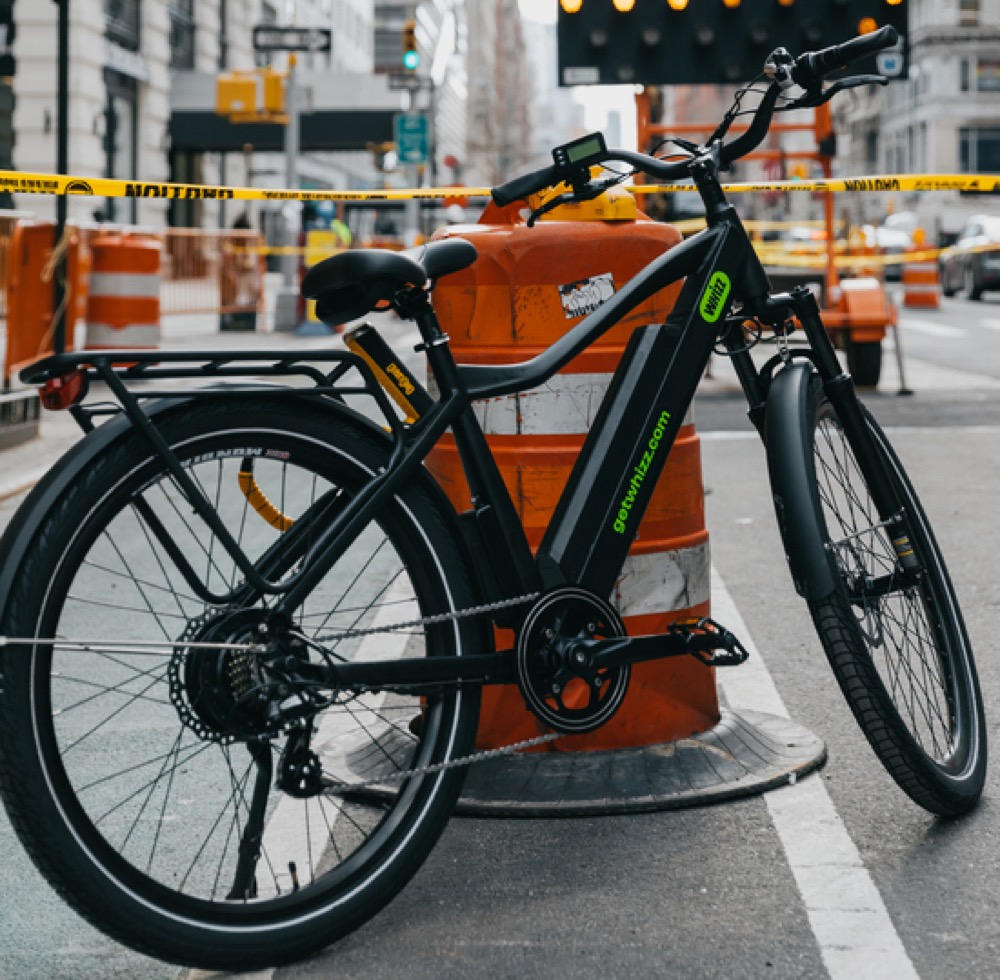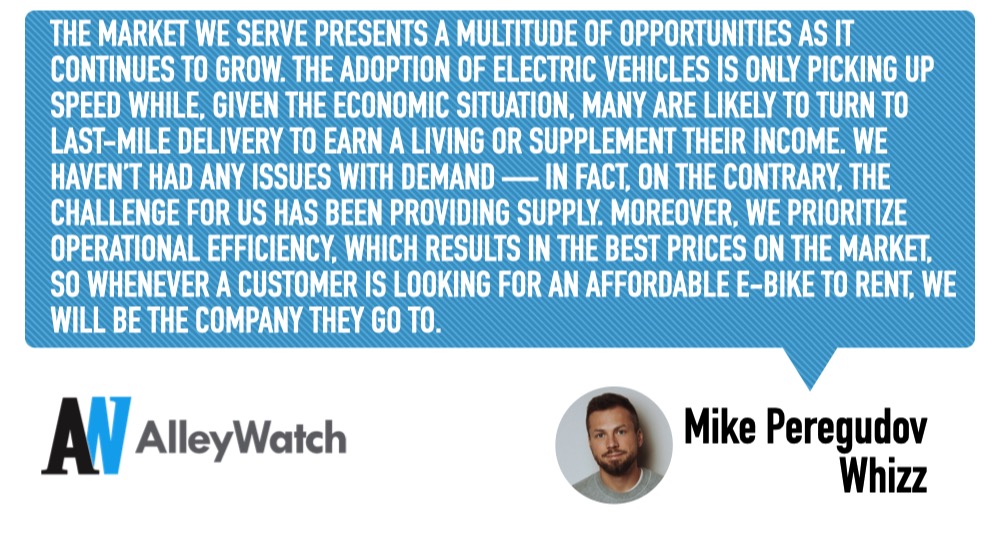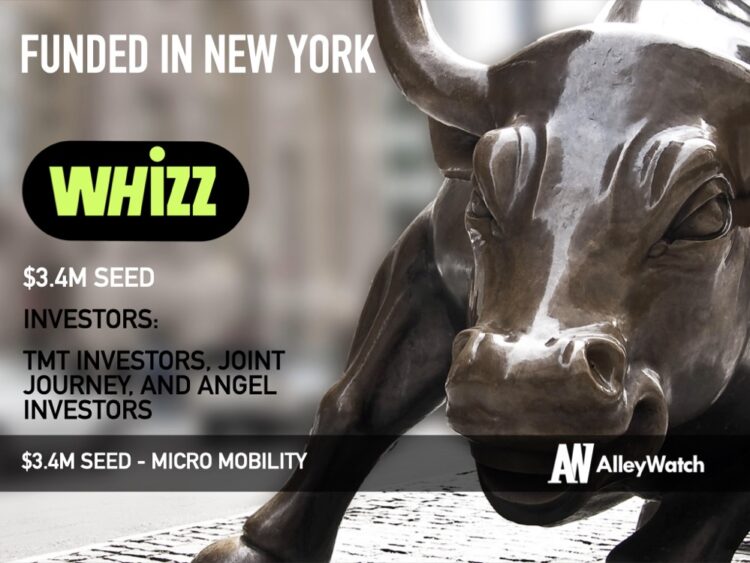There are estimated to be over 65,000 app-based delivery workers in New York alone. The advent of e-bikes has transformed the delivery industry, providing a massive employment opportunity with strong growth expected to continue. However, with the average cost of an e-bike exceeding $1500, the upfront cost can serve as a barrier for the predominantly immigrant workforce with limited credit histories. Whizz is a subscription e-bike service catered specifically towards delivery drivers. The bikes all offer 8 hours of battery life, built-in GPs, anti-theft systems, and are priced at an accessible $159 per month. Fourteen months after launch, the company has built $2M in recurring revenue and has been by over 2000 drivers with a 70% retention rate. Whizz is focused on the New York market, scaling its operations and technology with plans to expand to the 10 largest cities in the US next year.
AlleyWatch caught up with Whizz CEO and Cofounder Mike Peregudov to learn more about the business, the company’s strategic plans, latest round of funding, and much, much more…
Who were your investors and how much did you raise?
We recently closed a seed round of funding and raised $3.4M from Joint Journey, TMT Investments, and a group of angel investors. This brought our total fundraising to date to $4.5M.
Tell us about the product or service that Whizz offers.
Whizz is an e-bike subscription platform for last-mile delivery drivers, offering purpose-built e-bikes with eight hours of battery life, GPS trackers, and built-in anti-theft systems. We also provide on-demand maintenance and repairs at an industry-low price. Our service enables drivers to rent e-bikes, which typically cost over $1,500, for up to 20% less, offering last-mile delivery workers an affordable and sustainable transportation option.
What inspired the start of Whizz?
 We wanted to provide a transportation option for last-mile delivery drivers that is truly affordable and sustainable. We all see and meet these key workers every day, yet the value they provide often goes unrecognized and underappreciated. The businesses they serve don’t provide them with vehicles, they often don’t have time or place for a rest or snack, and if their bike breaks they are out of a job for days without income — which is often critical for contractors. To make matters worse, we noticed that many drivers, especially immigrant workers, could not afford to purchase e-bikes, which are becoming increasingly popular for their cost-efficiency and agility. We had to change that, and we saw an opportunity to provide a rental service that is affordable and tailored to the specific needs of the growing number of independent delivery drivers.
We wanted to provide a transportation option for last-mile delivery drivers that is truly affordable and sustainable. We all see and meet these key workers every day, yet the value they provide often goes unrecognized and underappreciated. The businesses they serve don’t provide them with vehicles, they often don’t have time or place for a rest or snack, and if their bike breaks they are out of a job for days without income — which is often critical for contractors. To make matters worse, we noticed that many drivers, especially immigrant workers, could not afford to purchase e-bikes, which are becoming increasingly popular for their cost-efficiency and agility. We had to change that, and we saw an opportunity to provide a rental service that is affordable and tailored to the specific needs of the growing number of independent delivery drivers.
How is Whizz different?
Unlike traditional e-bike rentals or ownership, Whizz offers a subscription-based service tailored specifically to last-mile delivery drivers’ needs. Our subscriptions are cheaper than similar services, our batteries last longer, and we offer on-demand repairs or exchanges should a user’s bike break down. Also, our proprietary Whizz Automation Platform, a one-of-a-kind ERP system for business process automation, has enabled us to automate key business processes and reduce operational costs by 35%. This helps us to keep our costs low so we can pass those savings on to our customers.
What market does Whizz target and how big is it?
We’re focused on the US last-mile delivery services market, which is growing rapidly and is predicted to comprise seven million gig delivery workers by 2025. We feel that e-bikes are primed to capitalize on this growth due to their agility and cost efficiency compared to other forms of transport. Right now, our focus is on New York, but we plan to expand to other states in the next few years.

What’s your business model?
We offer a subscription-based e-bike rental service with plans starting from $159/month. Our service serves drivers from Uber Eats, DoorDash, and Grubhub. In other words, those who need reliable transportation to earn a living. We’ve sustained 20% month-over-month growth and have reached $2 million in annual recurring revenue (ARR). We launched just 14 months ago and, by the beginning of 2023, we were already a profitable company at the contribution margin level.
How are you preparing for a potential economic slowdown?
The market we serve presents a multitude of opportunities as it continues to grow. The adoption of electric vehicles is only picking up speed while, given the economic situation, many are likely to turn to last-mile delivery to earn a living or supplement their income. We haven’t had any issues with demand — in fact, on the contrary, the challenge for us has been providing supply. Moreover, we prioritize operational efficiency, which results in the best prices on the market, so whenever a customer is looking for an affordable e-bike to rent, we will be the company they go to.

What was the funding process like?
The funding process was both exciting and challenging, as it always is for startups. It required plenty of preparation, networking, and persistence. We had to create a solid business plan, prepare pitch decks, and attend various events to showcase our company and product. But our key selling point was our operational efficiency and growth — we are already profitable on the contribution margin level — so investors knew they were putting their money in safe hands.
What are the biggest challenges that you faced while raising capital?
It’s a competitive landscape and investors are tightening their belts amid the economic downturn. As a relatively new company, we had to show our potential investors that we were not just another rental service, but a unique platform that can effectively solve urban commuters’ and delivery workers’ biggest problems. On top of that, we also had to demonstrate the significant potential of our services and the scalability of our business model. Thankfully, our early success provided plenty of proof of the sheer demand there is for our service.
What factors about your business led your investors to write the check?
There was a combination of factors. We have a strong team with a deep understanding of the market we’re targeting, and we have a clear vision of where we want to take the company, as well as a plan for how to get there. However, our investors were particularly impressed by our unique Whizz Automation Platform, developed in-house, which gives us a competitive advantage in the market. Combined, these factors helped them to recognize the potential of Whizz’s business model to serve the growing last-mile delivery services market.
There was a combination of factors. We have a strong team with a deep understanding of the market we’re targeting, and we have a clear vision of where we want to take the company, as well as a plan for how to get there. However, our investors were particularly impressed by our unique Whizz Automation Platform, developed in-house, which gives us a competitive advantage in the market. Combined, these factors helped them to recognize the potential of Whizz’s business model to serve the growing last-mile delivery services market.
What are the milestones you plan to achieve in the next six months? Where do you see the company going now over the near term?
We’re focused on intensively upgrading our Whizz Automation Platform and opening new locations in New York complete with lounge zones, bike maintenance and repair stations, and overnight storage facilities. Our goal is to establish leadership in New York in 2023 and then scale to the ten largest cities in the US in 2024. Eventually, we intend to serve drivers throughout the United States.
What advice can you offer companies in New York that do not have a fresh injection of capital in the bank?
Investors are selecting startups to invest in more carefully now. They want to see actual numbers and positive results, not just a cool idea that might turn a profit in decades’ time. Show them how you will make them money and not just burn through their cash — if you can do that, you’re golden.
With a plethora of commuting options in the city, how do you typically get to work each day?
Weather permitting, as the cofounder of Whizz, I usually use one of our e-bikes to get from my home in Williamsburg, Brooklyn, to our office in Manhattan each day. It’s a great way to stay in touch with our product and experience the city in a more sustainable way.





